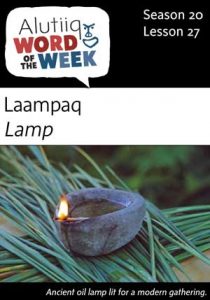 Laampaq–Lamp
Laampaq–Lamp
Laam’paaq kuarsgu.–Light the lamp.
From Kodiak to Greenland, Native people used stone oil lamps to heat and light their homes. On Kodiak, artisans formed lamps from beach cobbles of sandstone, granite, or a greenish-gray igneous stone called tonalite. Craftsmen formed lamps by sanding and pecking—banging one cobble against another. Although time-consuming, this technique produced many beautiful pieces. Some artists decorated their lamps with elaborate figurines and geometric designs. Sea mammals and human faces are some of the three-dimensional carvings that decorated Alutiiq lamps.
Alutiiq oil lamps come in many sizes. Household lamps were large, heavy pieces designed for stability. Travelers squatted over smaller, more portable lamps to warm themselves, and children played with tiny lamp replicas. Alutiiq Elders recall that lamps were filled with sea mammal oil and lit with wicks of twisted moss or cotton grass. Each lamp had a spirit, and when not in use, it was stored upside down to keep the spirit from escaping. Archaeologists often find upside down lamps in old houses. Today a burning oil lamp is a sign of prosperity and cultural endurance. The light of Alutiiq culture shines brightly as Elders and youth gather around a glowing lamp.
Source: Alutiiq Museum
[xyz-ihs snippet=”Adsense-responsive”]
